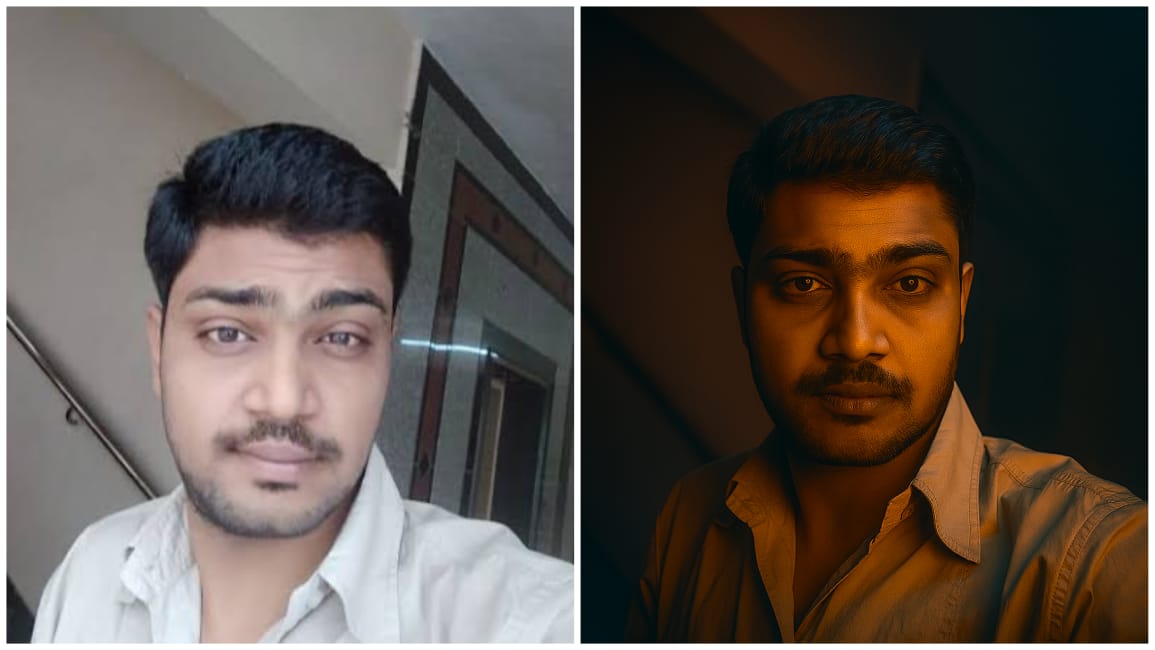In today’s digital world, capturing visually striking portraits isn’t just for professional photographers. With the rise of AI image tools and editing software, anyone can generate stunning, cinematic-style portraits that evoke emotion and storytelling — all with a single prompt.
One such prompt is:
👉 “Create a close-up portrait in cinematic style with bold lighting from the side. Match natural face angle and retain original background. Add slight orange-blue color grading.”
This guide breaks down the prompt step-by-step, explores where and how to use it, and explains how tools like Midjourney, DALL·E, and Photoshop can help you bring this vision to life.
🔍 Prompt Breakdown
Let’s explore what each part of this prompt means:
1️⃣ “Create a close-up portrait“
- Close-up: This frames the subject tightly, usually from shoulders up.
- Ideal for emotional intensity and facial detail.
2️⃣ “In cinematic style“
- Think moody, storytelling-based visuals, like scenes from a film.
- Often includes shallow depth of field, thoughtful composition, and rich color tones.
3️⃣ “With bold lighting from the side“
- Dramatic side lighting casts shadows on one half of the face, creating mystery and depth.
- Mimics classic film noir and studio portrait lighting.
4️⃣ “Match natural face angle“
- Keep the original pose or face tilt from the source image.
- This keeps the portrait believable and personal.
5️⃣ “Retain original background“
- Don’t replace the background — just enhance it subtly.
- Useful if you’re using a selfie or reference image.
6️⃣ “Add slight orange-blue color grading“
- Popular in film post-production (orange skin tones + teal shadows).
- Enhances contrast and gives a cinematic polish.
🎨 Why This Prompt Works
✅ Emotionally powerful: Bold side lighting and expressive close-up make your subject look strong, vulnerable, or mysterious — depending on their expression.
✅ Aesthetically rich: Orange-blue grading creates a familiar cinematic tone, making the image instantly feel like a film scene.
✅ Flexible: Works well for professional portraits, profile pictures, actor headshots, and even AI-generated characters.
🧠 Where You Can Use This Prompt
📸 AI Tools:
- MidJourney: Use prompt with aspect ratio –ar 4:3 for portraits.
- DALL·E 3 / ChatGPT: Upload a reference image and use this prompt to generate a cinematic look.
- Runway ML or Leonardo.Ai: Great for fine-tuning lighting and color grading.
🖼️ Editing Apps:
- Lightroom/Photoshop: Manually add bold side lighting and orange/blue LUTs.
- Canva Pro: Some cinematic filters mimic this style for lightweight use.
👥 Use Cases:
- Actor/model headshots
- Business or artistic portfolio portraits
- Social media profile upgrade
- Film posters or AI movie concepts
🛠️ How to Enhance Results Further
🎯 Face expression: Keep it neutral or slightly thoughtful to match cinematic tone.
🎯 Hair & outfit: Add contrast (dark clothing against soft background). Tidy hair improves focus on face.
🎯 Background blur: Use shallow depth of field (blur background, sharpen face).
🎯 Color grading: In apps like Lightroom, increase warmth (orange) in highlights and add cool tones (teal/blue) in shadows.
🤖 Can This Be Used in ChatGPT or Other AI Tools?
Absolutely. You can:
- Upload a selfie and pair it with the full prompt.
- Generate photo-editing instructions.
- Use it to design social media graphics, film-inspired posts, or client mockups.
Example Use in ChatGPT+DALL·E:
“Here’s my selfie. Create a cinematic portrait. Close-up shot, side lighting, natural face angle, keep my background. Add subtle orange/blue color grading.”
🧩 Final Thoughts
This prompt lets you merge real-world imagery with cinematic imagination. Whether you’re a photographer, designer, actor, or just someone who wants to stand out online, this portrait style adds storytelling depth and professional polish.
🎥 Cinematic portraits aren’t just pictures — they’re moments frozen in time.
📌 Prompt Recap:
“Create a close-up portrait in cinematic style with bold lighting from the side. Match natural face angle and retain original background. Add slight orange-blue color grading.”








